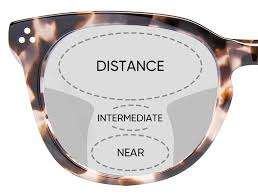Progressive Lenses: Pros and Cons You Should Know
Progressive lenses, also called multifocal or no-line bifocals, are corrective lenses designed to provide clear vision at multiple distances. Unlike traditional bifocal or trifocal lenses, progressive lenses have a seamless transition between different prescription zones, offering a more natural and modern appearance.
These lenses are commonly used to correct presbyopia and other accommodation disorders, allowing users to read, work on computers, and see distant objects clearly—all with one pair of glasses.
What Are Progressive Lenses?
How Progressive Lenses Work
Progressive lenses combine three prescriptions in one lens:
- Top section: For distance vision, such as driving.
- Middle section: For intermediate tasks, like computer work.
- Bottom section: For close-up activities, such as reading.
The transition between these prescriptions is gradual, making the lenses appear similar to single-vision glasses while providing multifocal functionality.

Who Needs Progressive Lenses?
People aged 35-40 and older often experience presbyopia, a condition where the eye's natural lens loses flexibility, making it difficult to focus on nearby objects. Progressive lenses eliminate the need for separate reading and distance glasses, offering convenience and improved vision quality.
Advantages of Progressive Lenses
1. All-in-One Solution
Progressive lenses eliminate the need to switch between multiple pairs of glasses. With one pair, users can perform tasks requiring different focal distances, such as reading, working on a computer, and driving.
2. No Visible Bifocal Line
Unlike bifocal lenses, progressive lenses have a smooth, seamless transition between prescriptions. This eliminates the distracting line found in bifocals and allows for a more natural viewing experience. It's particularly useful for activities like driving, where abrupt prescription changes can be hazardous.
3. Modern and Stylish Appearance
Progressive lenses look just like single-vision glasses, making them a preferred choice for those who want a youthful, modern aesthetic. They avoid the visual cues often associated with bifocals, which some may consider outdated.
Disadvantages of Progressive Lenses
1. Adjustment Period
Adapting to progressive lenses can take time. Users must train their eyes to navigate the lens zones:
- Look straight ahead for distance vision.
- Use the middle section for intermediate tasks.
- Shift focus to the lower section for reading.
During this period, headaches, dizziness, and nausea are common. While most people adjust within a few weeks, some may never fully adapt.
2. Potential Visual Distortions
The gradual prescription changes can cause peripheral distortions. For example:
- Climbing stairs or curbs: Objects viewed through the reading section may appear larger, making it challenging to judge distances accurately.
- Peripheral vision issues: Slight blurriness or warping may occur at the edges of the lenses.
These distortions typically decrease as the user becomes accustomed to the lenses.
3. Higher Cost
Progressive lenses are more expensive than bifocals or single-vision glasses due to their advanced design and functionality. While they offer greater convenience and a more natural visual experience, the higher price may be a barrier for budget-conscious buyers.
Key Takeaways on Progressive Lenses
Progressive lenses are a versatile and modern solution for individuals with presbyopia or other vision needs requiring multiple prescriptions. They offer convenience, style, and functionality in a single pair of glasses, making them an attractive option for many.
However, they come with a higher price and a learning curve that may not suit everyone. Ultimately, whether progressive lenses are the right choice depends on your lifestyle, budget, and visual priorities. Consult with your optometrist to find the best fit for your needs.
Share this post
Varifocal Lenses: How They Work, Benefits, and Drawbacks
Varifocal lenses, also known as progressive lenses, provide seamless vision correction for various distances. They eliminate the need for multiple pairs of...
Lenses And Coatings
At XCombo.com, we are committed to providing high-quality prescription lenses tailored to every pair of frames you purchase. Our affordable and reliable...
Understanding CYL, AXIS, and SPH in Eye Prescriptions
When you receive an eye prescription, you may notice terms like CYL, AXIS, and SPH. These are essential measurements that help determine...
Blue Light Blocking Lens
Blue-ray exists everywhere todayWith the widespread use of electronic screens, more people suffer from eyestrain symptoms when using electronic devices. One of...
Trivex Lenses Explained: Differences, Advantages, and Considerations
Trivex lenses have gained significant attention in the eyewear industry as an advanced alternative to traditional lenses. Known for their durability, lightweight...

